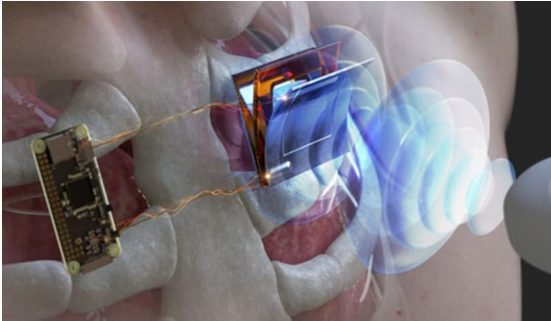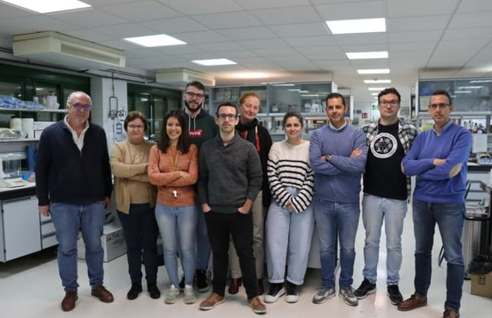The First Battery Prototype Using Hemoglobin 
by Andrew Corselli February 2024
A team at the University of Cordoba has developed a battery that uses hemoglobin as an electrochemical reaction facilitator, functioning for around 20-30 days.
 “Our hemoglobin-based zinc-air battery has similar working conditions to the human body. Because of that, we consider that is an appropriate battery for any electronic devices integrated into the human body,” said Lead Author Manuel Cano Luna. (Image: The researchers)
“Our hemoglobin-based zinc-air battery has similar working conditions to the human body. Because of that, we consider that is an appropriate battery for any electronic devices integrated into the human body,” said Lead Author Manuel Cano Luna. (Image: The researchers)
Hemoglobin is a protein present in red blood cells and is responsible for conveying oxygen from the lungs to the different tissues of the body (and then transferring carbon dioxide the other way around). It has a very high affinity for oxygen and is fundamental for life, but, what if it were also a key element for a type of electrochemical device in which oxygen also plays an important role, such as zinc-air batteries?
This is what the Physical Chemistry (FQM-204) and Inorganic Chemistry (FQM-175) groups at the University of Córdoba (UCO) wanted to verify and develop, together with a team from the Polytechnic University of Cartagena, after a study by the University of Oxford and a Final Degree Project at the UCO demonstrated that hemoglobin featured promising properties for the reduction and oxidation (redox) process by which energy is generated in this type of system. Thus, the research team developed, through a Proof-of-Concept project, the first biocompatible battery (which is not harmful to the body) using hemoglobin in the electrochemical reaction that transforms chemical energy into electrical energy.
Using zinc-air batteries, one of the most sustainable alternatives to those that currently dominate the market (Li-ion batteries), hemoglobin would function as a catalyst in such batteries. That is, it is a protein that is responsible for facilitating the electrochemical reaction, called the Oxygen Reduction Reaction (ORR), causing, after the air enters the battery, oxygen to be reduced and transformed into water in one of the parts of the battery (the cathode or positive pole), releasing electrons that pass to the other part of the battery (the anode or negative pole), where zinc oxidation occurs.
"To be a good catalyst in the oxygen reduction reaction, the catalyst has to have two properties: it needs to quickly absorb oxygen molecules, and form water molecules relatively easily,” said Lead Author Manuel Cano Luna. “And hemoglobin met those requirements." In fact, through this process, the team managed to get their prototype biocompatible battery to work with 0.165 milligrams of hemoglobin for between 20 and 30 days.

In addition to strong performance, the battery prototype they have developed boasts other advantages. First, zinc-air batteries are more sustainable and can withstand adverse atmospheric conditions, unlike other batteries affected by humidity and requiring an inert atmosphere for their manufacture. Secondly, as Cano Luna noted, "The use of hemoglobin as a biocompatible catalyst is quite promising as regards the use of this type of battery in devices that are integrated into the human body," — e.g., pacemakers. The battery operates at pH 7.4, which is a pH similar to that of blood. In addition, since hemoglobin is present in almost all mammals, proteins of animal origin could also be used.
The research team of the University of Cordoba. (Image: University of Cordoba)
The battery they have developed has some room for improvement, however. The main one is that it is a primary battery, so it only discharges electrical energy. Also, it is not rechargeable. Therefore, the team is already taking the next steps to find another biological protein that can transform water into oxygen and, thus, recharge the battery. In addition, the batteries would only work in the presence of oxygen, so they could not be used in space.
Here is an exclusive Tech Briefs interview — edited for length and clarity — with Cano Luna.
Tech Briefs: What made you choose hemoglobin? How did you decide on that?
Cano Luna: We were inspired by a research paper that reported the electrocatalytic properties of Hemoglobin (Hb) for the Oxygen Reduction Reaction (ORR).
It should be noted that ORR is a key cathodic reaction produced in hydrogen fuel cells and in zinc-air batteries (two important electrochemical devices for energy storage and conversion).
Tech Briefs: What was the biggest technical challenge you faced while developing this battery technology?
Cano Luna: Our major challenge was choosing the best combination of Hb and Nafion, in terms of long-term stability. Hb protein is very soluble in water. Therefore, to keep this protein on the surface of the air electrode, it was necessary to use Nafion.
Basically, Nafion ionomer is a polymer, that acts like a membrane, thus avoiding the loss of Hb from the electrode surface.
Tech Briefs: Can you explain in simple terms how it works?
Cano Luna: Hb acts as an electrocatalyst in the cathodic reaction, adsorbing O2 from the air and reducing this O2 to H2O (ORR) with a four-electron pathway (i.e. performing both actions efficiently).
ORR on a bare working electrode typically leads to the formation of hydrogen peroxide, which involves a two-electron transfer: O2 + 2H+ + 2e- ® H2O2.
While a Hb-modified working electrode allows a four-electron conversion to water (i.e. the desirable one): O2 + 4H+ + 4e- ® H2O.
Tech Briefs: What are the pros and cons of using hemoglobin batteries?
Cano Luna: Main advantage: The use of a biological protein as an ORR catalyst and an aqueous electrolyte solution at a neutral pH of 7.4 (i.e. physiological conditions) makes zinc-air batteries much more biocompatible, less dangerous, and more environmentally friendly.
Related Articles
Fundamental EV Battery Models Explain New Tab Design
Internal Short Circuit (ISC) Device Helps Improve Li-ion Battery Design
Main disadvantage: The use of a biological molecule as an electrocatalyst limits the working conditions of this energy storage device, causing it to be not useful in extreme conditions (e.g. high temperature causes protein denaturation).
Tech Briefs: The article says, “The team is already taking the next steps to find another biological protein that can transform water into oxygen and, thus, recharge the battery.” How is that coming along? Any updates you can share?
Cano Luna: Currently, we are testing several proteins as possible electrocatalysts for Oxygen Evolution Reaction (OER). Once we choose the best candidate, the next step will be to identify a perfect combination with Hb, aiming for a “synergistic effect” between both proteins. OER is the reaction for charging the zinc-air battery: 2H2O ® O2 + 4H+ + 4e-.
Tech Briefs: What are your next steps? Any other future research/work/etc. on the horizon?
Cano Luna: Our current efforts are focused on making this battery rechargeable, using only biological molecules as electrocatalysts. We consider that as a new research line in the field of zinc-air battery
